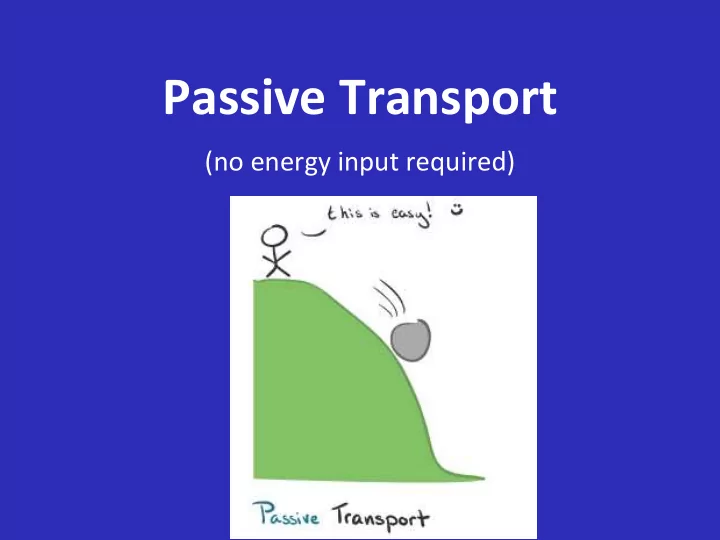

Passive Transport (no energy input required)
Passive Transport • Passive transport is the movement of ions and other molecules across cell membranes without the need of energy input (ATP) • Ions or molecules move from an area of higher concentration to an area of lower concentration (with the gradient) • Three types: simple diffusion , facilitated diffusion , and osmosis
Passive Versus Active Transport
Important Vocabulary • Concentration gradient – an unequal distribution of solutes across the cell membrane • Equilibrium – concentration of molecules is equal inside and outside of the cell
Concentration Gradient
Simple Diffusion
Simple Diffusion • Movement of molecules from an area of higher concentration to an area of lower concentration ( with the concentration gradient ) • Molecules will continue to diffuse until equilibrium is reached
What type of molecules diffuse through the phospholipid bilayer? • Small non-polar molecules, such as O 2 and CO 2 • Some polar molecules, such as H 2 O (slowly)
Example of Diffusion • Simple diffusion is the process by which oxygen and carbon dioxide are exchanged between the blood cells and body tissues
Facilitated Diffusion
Facilitated Diffusion • Facilitated diffusion is diffusion that is assisted by channel or carrier proteins • Rate of diffusion depends on the number of proteins available • Molecules or ions are moving from high to low concentration
What types of materials are transported by facilitated diffusion? • Larger molecules such as glucose and amino acids • Ions (Cl - , K + , Na + and Ca 2+ )
Simple Versus Facilitated Diffusion
Complete the following: • In your notes, create a Venn diagram to compare and contrast simple and facilitated diffusion • Watch the following video (3 minutes): Simple and Facilitated Diffusion
Osmosis
Osmosis • Diffusion of water across a semi-permeable membrane • Water will diffuse to reach equilibrium • Utilizes specialized channel proteins called aquaporins
Aquaporins • Channel proteins that facilitate the diffusion of water across the membrane
Osmosis
Osmosis and Cells • Critical balance of water between a cell and its environment • Different solutions (environments) can affect a cells internal water content
Tonicity and Osmosis
Isotonic Environment • In an isotonic environment, the cell has the same concentration of dissolved solutes as the surrounding solution • No net movement of water into or out of the cell • Cell will retain its shape
Hypotonic Environment • In a hypotonic environment, the cell has a higher concentration of dissolved solutes than the surrounding environment • Water will diffuse into the cell until equilibrium is reached • The cell will swell and could possibly burst ( lyse )
Hypertonic Environment • In a hypertonic environment, the cell has a lower concentration of dissolved solutes than the surrounding environment • Water will diffuse out of the cell until equilibrium is reached • The cell will crenate (shrink)
Adaptations for Osmosis • Fresh and salt water fish have the ability to osmoregulate • Paramecia have a contractile vacuole to control water intake
Osmosis Reminder : SALT SUCKS!
Osmosis in Plant Cells • Less affected by osmosis due to protection of the cell by the cell wall • Water content affects the size of the vacuole Plasmolysis Turgid
Plasmolysis • Cell membrane pulls away from cell wall, occurs in hypertonic conditions Turgid (or Turgor Pressure) • Cytoplasm and vacuole press against cell wall, occurs in hypotonic conditions
Complete the following: • Watch the following video (10 minutes): Osmosis and Water Potential
Recommend
More recommend